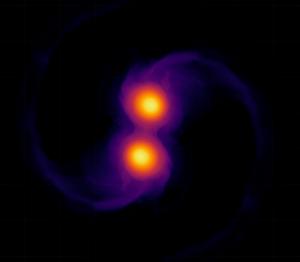This simulation depicts the merger of two neutron stars, which are the ultra-dense corpses of massive stars that exploded as supernovae. Recent work shows that as the neutron stars merge, they can revolve around each other at up to 78,000 times per second, generating gravitational waves that ripple through the universe. When the stars merge, that high-speed rotation would hold them up against their combined gravity, preventing the merged stars from collapsing to form a black hole -- for less than a second. Astronomers have found two possible such mergers in observations from the 1990s. [NASA/GSFC/STAG Research Centre/Peter Hammond]
You are here
Noisy Mergers
A hypermassive neutron star defies gravity. Instead of instantly collapsing to form a black hole, it keeps itself puffed up. But only for a while. In the end, gravity always wins.
A neutron star is the ultra-dense corpse of a once mighty star. It’s more massive than the Sun, but smaller than the city limits of Chicago.
Neutron stars have a weight limit — about twice the mass of the Sun. If they pack on more, they collapse to form a black hole.
But there may be a way for a neutron star to hold up against that limit: from the merger of two neutron stars. If they come together in the right way, they might resist gravity by spinning extremely fast — up to 78 thousand times a minute.
That would churn up the surrounding space-time, producing tiny ripples known as gravitational waves. Future observatories should be able to “hear” those ripples as the stars approach each other, as depicted in this simulation. [audio]
The ripples would end with a “chirp” as the combined stars finally surrendered, forming a black hole. From merger to collapse, it should all be over in less than a second.
The black hole would “ring” like a bell for a while longer as it settled down, producing more waves. No one has yet “heard” that ringing. But a recent study found two candidate mergers from the 1990s. They were accompanied by intense bursts of gamma rays — bright flashes before the ultimate darkness.
More about gravitational waves tomorrow.
Script by Damond Benningfield
Get Premium Audio
Listen to today's episode of StarDate on the web the same day it airs in high-quality streaming audio without any extra ads or announcements. Choose a $8 one-month pass, or listen every day for a year for just $30.







